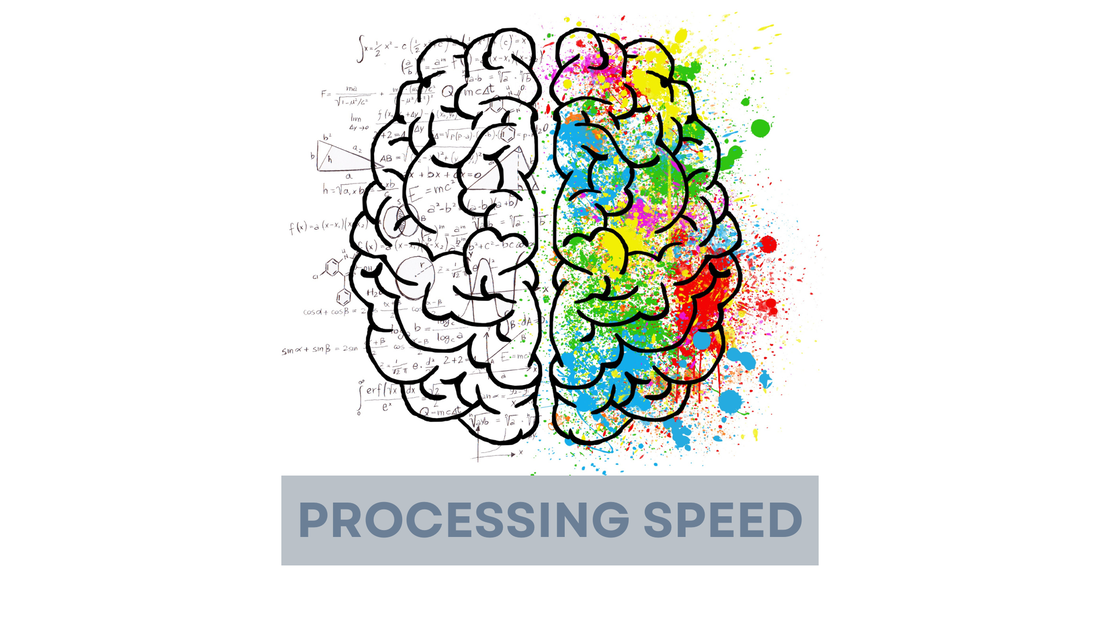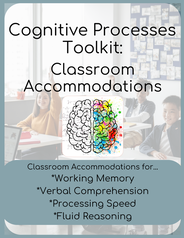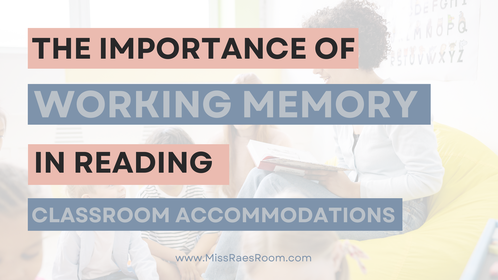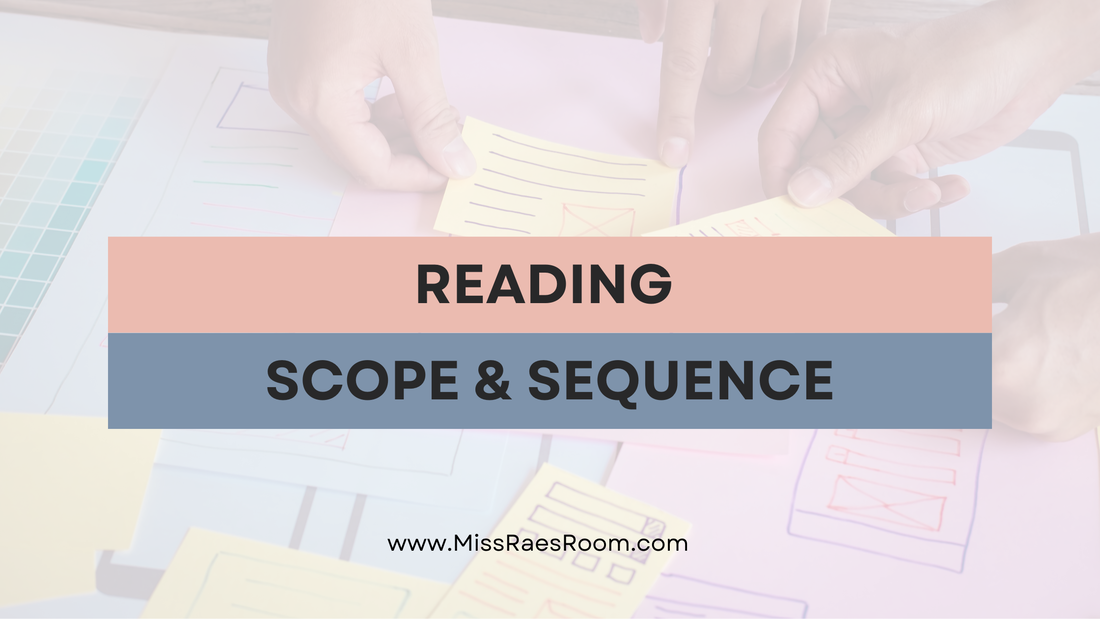Empowering Teachers: Strategies for Supporting Students with Processing Speed (RAN) Challenges
Explore the impact of Processing Speed on students' learning and discover effective strategies and accommodations to enhance their academic progress. Gain insights into the connection between Processing Speed, Rapid Automatized Naming (RAN), reading, math, and overall learning outcomes. Empower your students with the tools and support they need to overcome challenges and unlock their full potential.
Speed, the essence of our fast-paced world, seems to define success. But what if I told you that speed isn't everything? In the realm of education, we encounter students who process information at different rates, like unique individuals navigating the bustling streets of a busy city. Welcome to the intriguing world of Processing Speed, where understanding the nuances of how our students process information can unlock their true potential.
Join me on a journey as we delve into the complexities of Processing Speed, explore its impact on reading, math, and learning, uncover assessment strategies, and discover practical methodologies and accommodations that empower our students to thrive. We will also talk about Rapid Automatized Naming (RAN) tasks and how they relate to Processing Speed.
It's time to unravel the mystery of Processing Speed and pave the way for personalized learning experiences. Let's dive in!
Join me on a journey as we delve into the complexities of Processing Speed, explore its impact on reading, math, and learning, uncover assessment strategies, and discover practical methodologies and accommodations that empower our students to thrive. We will also talk about Rapid Automatized Naming (RAN) tasks and how they relate to Processing Speed.
It's time to unravel the mystery of Processing Speed and pave the way for personalized learning experiences. Let's dive in!
What is Processing Speed?
|
Processing Speed is a fascinating cognitive ability that plays a crucial role in how students interact with information in their academic pursuits.
Processing Speed encompasses a range of skills, including visual identification, decision-making, decision implementation, visual scanning, visual discrimination, short-term visual memory, visuomotor coordination, and concentration. Essentially, it reflects how quickly and accurately students can process and respond to visual stimuli. |
A significant measure closely associated with Processing Speed is Rapid Automatized Naming (RAN). RAN tasks gauge the speed at which students can verbally name objects, pictures, colors, or symbols like letters or digits. It is a powerful predictor of fluency and later reading abilities, with RAN for letters and digits exhibiting particularly strong correlations with reading skills.
You can read more about RAN HERE!
It's important to note that not all individuals with Dyslexia exhibit slow RAN. Extensive research by Maryanne Wolf reveals that it affects nearly half of people with Dyslexia. Some students with Dyslexia may solely experience phonological difficulties, where their RAN performance may be average, but they struggle with tasks related to phonological awareness and/or phonological memory. Conversely, the Double-Deficit Phenomenon refers to students who face challenges in both phonological awareness and Processing Speed (RAN). These students often experience more severe reading difficulties, requiring longer periods of remediation.
Research findings indicate that students with isolated deficits in RAN, without phonological awareness issues, tend to have milder reading difficulties compared to those with phonological awareness deficits.
Understanding the intricacies of Processing Speed and its relationship to reading can help educators tailor their approaches and interventions to better support students with varying learning profiles.
You can read more about RAN HERE!
It's important to note that not all individuals with Dyslexia exhibit slow RAN. Extensive research by Maryanne Wolf reveals that it affects nearly half of people with Dyslexia. Some students with Dyslexia may solely experience phonological difficulties, where their RAN performance may be average, but they struggle with tasks related to phonological awareness and/or phonological memory. Conversely, the Double-Deficit Phenomenon refers to students who face challenges in both phonological awareness and Processing Speed (RAN). These students often experience more severe reading difficulties, requiring longer periods of remediation.
Research findings indicate that students with isolated deficits in RAN, without phonological awareness issues, tend to have milder reading difficulties compared to those with phonological awareness deficits.
Understanding the intricacies of Processing Speed and its relationship to reading can help educators tailor their approaches and interventions to better support students with varying learning profiles.
Impact on Reading
Processing Speed plays a crucial role in reading development and performance. Students with poor Rapid Automatized Naming (RAN) often struggle with processing language, resulting in reading difficulties.

Slower-than-average RAN scores are frequently associated with challenges in word-level reading, where readers need to attend to individual words in a text.
Word-level reading heavily relies on phonological and phonemic skills.
Difficulties in accessing phonemes within spoken words can have a negative impact on reading development. This can affect students' phonics acquisition, sight word recognition, and overall fluency.
Students with lagging skills in Processing Speed/RAN may exhibit the following:
Word-level reading heavily relies on phonological and phonemic skills.
Difficulties in accessing phonemes within spoken words can have a negative impact on reading development. This can affect students' phonics acquisition, sight word recognition, and overall fluency.
Students with lagging skills in Processing Speed/RAN may exhibit the following:
- Slow language processing ability, leading to difficulties in comprehension.
- Struggles with word-level reading, affecting quick decoding and impeding reading speed.
- Challenges with timed tasks and reduced ability to produce written work within the same timeframe as their peers.
- Difficulty with rapid spelling, negatively impacting written expression and the ability to quickly translate thoughts onto paper while maintaining proper sentence structure.
Impact on Mathematics:

Processing Speed also influences mathematical performance in various ways:
- Retrieving math facts, particularly during timed tests, tends to be slower for individuals with processing difficulties.
- Completing mathematical calculations may take longer due to the time needed to process and manipulate numerical information.
- Word finding difficulties can be observed in explanations of mathematical thinking, as individuals may struggle to recall the appropriate terminology.
Other Learning Impacts:
|
In addition to reading and mathematics, a slow Processing Speed can affect various aspects of learning, including:
|
By understanding the various ways in which Processing Speed impacts reading, math, and learning in general, educators can implement appropriate strategies and accommodations to support students with processing difficulties. But how do we truly know if a student has decreased Processing Speed?
Measuring Processing Speed:
|
When it comes to assessing Processing Speed, educators and professionals utilize specific tests and measures to evaluate a student's abilities. Here are two commonly used assessments:
1. WISC-IV: Processing Speed Index The Processing Speed Index (PSI) is a component of the Wechsler Intelligence Scale for Children-Fourth Edition (WISC-IV). The WISC-IV measures a student's speed and accuracy in visual identification, decision-making, and decision implementation. Performance on the PSI is associated with skills such as visual scanning, visual discrimination, short-term visual memory, visuomotor coordination, and concentration. |
PSI includes two subtests:
2. Rapid Automatized Naming (RAN) Assessment
The RAN assessment is another method used to evaluate Processing Speed. During this assessment, students are presented with a sheet of letters, colors, objects, or numbers, and they are asked to name each item as quickly as possible within a specific time limit. Research has shown that completing this activity more slowly than other students can accurately predict difficulties with reading.
By utilizing these assessments, educators and professionals can gain valuable insights into a student's Processing Speed abilities, identify areas of strengths and weaknesses, and make informed decisions regarding appropriate interventions and accommodations.
- Symbol Search (SS): This subtest requires students to scan a group of symbols and indicate whether the target symbol is present or not.
- Coding (CD): In this subtest, students use a key to copy symbols that correspond with simple geometric shapes.
2. Rapid Automatized Naming (RAN) Assessment
The RAN assessment is another method used to evaluate Processing Speed. During this assessment, students are presented with a sheet of letters, colors, objects, or numbers, and they are asked to name each item as quickly as possible within a specific time limit. Research has shown that completing this activity more slowly than other students can accurately predict difficulties with reading.
By utilizing these assessments, educators and professionals can gain valuable insights into a student's Processing Speed abilities, identify areas of strengths and weaknesses, and make informed decisions regarding appropriate interventions and accommodations.
Methodologies
When working with students who have difficulties with Processing Speed, implementing specific methodologies can greatly support their reading and learning progress. Here are some effective strategies and approaches:
- Structured Literacy Approach to Reading: THIS systematic and explicit approach focuses on teaching the structure of language, including phonology, morphology, and syntax. By providing structured instruction in phonemic awareness, phonics, and decoding skills, students can develop a solid foundation for reading. Get my Five Step Reading Lesson plan HERE!
- Explicit Instruction in Fluency: Implement explicit instruction techniques to improve fluency skills. Model fluent reading, use strategies like "scoop sentences" (grouping words into meaningful phrases), and provide ample opportunities for repeated reading to build automaticity. Click HERE to learn more about teaching oral reading fluency!
- RAN Charts and Drills for Automaticity: Rapid Automatized Naming (RAN) charts and drills can be utilized to enhance automaticity in letter-sound correspondence, word parts (such as /am/ and /ip/), and whole words that incorporate previously learned skills. This helps students improve their Processing Speed and retrieval of information. Click HERE to learn more about RAN drills.
- Phonological Awareness Training: Depending on the student's profile, explicit instruction in phonological awareness can be beneficial. This involves activities and exercises that focus on recognizing and manipulating the sounds within words, helping students develop strong phonological skills. Check out a suggested scope and sequence HERE!
- Memory Strategies: Teach students memory strategies that can enhance their learning and access to information at a faster pace. Engage in games and activities that require quick thinking within a time limit, encouraging students to work efficiently and utilize their memory effectively. Click HERE to learn more about working memory!
Classroom Accommodations:
|
While research indicates that RAN training alone may not directly improve reading skills, we can provide instruction to enhance overall fluency, incorporating strategies that integrate reading skills.
It's important to note that a student's vocabulary size significantly influences fluency. Therefore, fluency instruction should prioritize building a sight vocabulary comprising both phonetically regular and irregular words. The goal is for students to instantly recognize and read these familiar words. |
For students with impaired RAN who have been diagnosed with Dyslexia, fluency should be defined differently. The focus should be on achieving a moderate rate and expressive reading, rather than emphasizing speed. Setting realistic goals and providing direct instruction tailored to address specific fluency challenges are crucial.
To support students with impaired RAN and Processing Speed difficulties, consider the following accommodations:
To support students with impaired RAN and Processing Speed difficulties, consider the following accommodations:
- Contextual Reading Goals: Instead of measuring reading speed, focus on defining specific goals for contextual reading. Emphasize comprehension, understanding, and expression while reading.
- Expression and Rate: Help students improve their expression while reading and work towards a moderate reading rate that suits their individual needs.
SETTING Accommodations
(These accommodations focus on a change in the student’s environment)
PRESENTATION Accommodations
(These accommodations focus on how the information will be provided to the student)
RESPONSE Accommodations
(These accommodations focus on how the student will provide information)
TIMING/SCHEDULING Accommodations
(These accommodations focus on altering time allocations or the schedule, such as a specific time of day, extra time, etc.)
Grab these accommodations HERE!
(These accommodations focus on a change in the student’s environment)
- Establish a structured and predictable classroom environment with clear schedules and routines, supported by visual aids.
- Begin tasks and transitions early to provide ample time and reduce anxiety.
PRESENTATION Accommodations
(These accommodations focus on how the information will be provided to the student)
- Deliver instructions in a clear, concise manner with explicit steps.
- Speak at a slower pace to allow students to process information effectively.
- Modify assignments to be more manageable in length, including homework.
- Check in frequently to ensure comprehension and offer additional support.
- Provide checklists or rubrics to help students track their progress and meet expectations.
- Clearly communicate the starting points for tasks, going beyond due dates.
- Break down large assignments into smaller, manageable components with individual deadlines.
- Teach and reinforce strategies for independence in completing tasks.
- Offer access to audiobooks or alternative formats for content materials.
- Provide completed or partially filled-out notes to support note-taking.
RESPONSE Accommodations
(These accommodations focus on how the student will provide information)
- Utilize graphic organizers to assist with organizing and structuring information.
- Implement text-to-speech tools or software to support reading and comprehension.
TIMING/SCHEDULING Accommodations
(These accommodations focus on altering time allocations or the schedule, such as a specific time of day, extra time, etc.)
- Allow for extended time or untimed tasks to accommodate Processing Speed and completion of learning tasks.
Grab these accommodations HERE!
You can track the accommodations a student uses with accommodation trackers. For students on IEPs, this helps us to ensure that we are accurately following them. Accommodation trackers are also helpful to tell us which ones are effective and which ones would further or better support our students!
In conclusion, understanding the impact of Processing Speed on students' learning experiences is crucial for educators.
By recognizing the challenges associated with Processing Speed, we can implement effective strategies and accommodations to support students' academic growth.
Through structured literacy approaches, explicit fluency instruction, phonological awareness training, and the use of memory strategies, we can help students improve their reading, math, and overall learning outcomes.
By providing environmental, presentation, response, and timing/scheduling accommodations, we create an inclusive learning environment where students with Processing Speed difficulties can thrive. Together, let's empower students and ensure they have the tools and support they need to reach their full potential.
Happy and healthy teaching!
PEACE,
Miss Rae
In conclusion, understanding the impact of Processing Speed on students' learning experiences is crucial for educators.
By recognizing the challenges associated with Processing Speed, we can implement effective strategies and accommodations to support students' academic growth.
Through structured literacy approaches, explicit fluency instruction, phonological awareness training, and the use of memory strategies, we can help students improve their reading, math, and overall learning outcomes.
By providing environmental, presentation, response, and timing/scheduling accommodations, we create an inclusive learning environment where students with Processing Speed difficulties can thrive. Together, let's empower students and ensure they have the tools and support they need to reach their full potential.
Happy and healthy teaching!
PEACE,
Miss Rae












